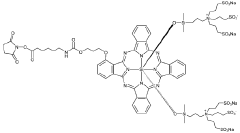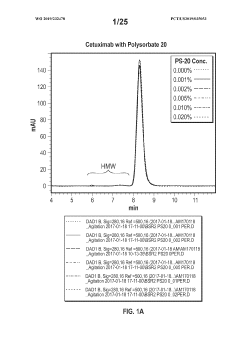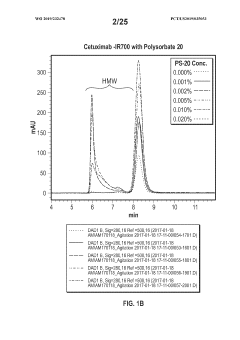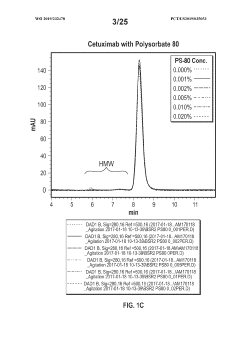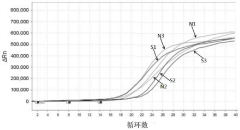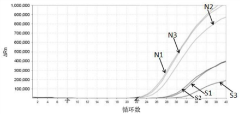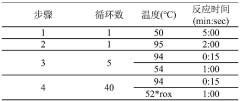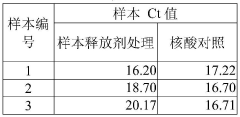Triton X-100 in Self-Assembled Monolayers for Sensor Applications
JUL 31, 20259 MIN READ
Generate Your Research Report Instantly with AI Agent
Patsnap Eureka helps you evaluate technical feasibility & market potential.
SAM Sensor Background
Self-assembled monolayers (SAMs) have emerged as a powerful platform for sensor applications, offering unique advantages in terms of molecular-level control and surface functionalization. The integration of Triton X-100, a non-ionic surfactant, into SAM-based sensors represents a significant advancement in this field. SAMs are formed by the spontaneous organization of molecules on a solid surface, creating a highly ordered and stable molecular structure.
The history of SAMs in sensor applications dates back to the 1980s when researchers first recognized their potential for creating well-defined surfaces with tailored properties. Since then, SAMs have been extensively studied and applied in various sensing technologies, including electrochemical, optical, and piezoelectric sensors. The ability to precisely control the surface chemistry and structure at the molecular level has made SAMs an attractive choice for developing highly sensitive and selective sensors.
Triton X-100, a widely used surfactant in biochemistry and molecular biology, has recently gained attention in the context of SAM-based sensors. Its incorporation into SAMs offers several potential benefits, including enhanced stability, improved molecular recognition, and increased sensitivity. The amphiphilic nature of Triton X-100 allows it to interact with both hydrophilic and hydrophobic molecules, making it particularly useful for detecting a wide range of analytes.
The development of SAM-based sensors incorporating Triton X-100 has been driven by the growing demand for more sensitive, selective, and reliable sensing platforms across various industries. These sensors have found applications in environmental monitoring, healthcare diagnostics, food safety, and industrial process control. The ability to detect trace amounts of specific molecules or compounds with high accuracy has made SAM-based sensors invaluable in many critical applications.
Recent advancements in nanotechnology and surface characterization techniques have further accelerated the progress in SAM-based sensor development. Techniques such as atomic force microscopy (AFM), surface plasmon resonance (SPR), and quartz crystal microbalance (QCM) have enabled researchers to study the formation, structure, and properties of SAMs at unprecedented levels of detail. This has led to a better understanding of the interactions between SAMs, Triton X-100, and target analytes, paving the way for more sophisticated sensor designs.
The integration of Triton X-100 into SAM-based sensors represents a convergence of multiple scientific disciplines, including surface chemistry, materials science, and analytical chemistry. This interdisciplinary approach has opened up new possibilities for sensor development, combining the strengths of different fields to create more effective and versatile sensing platforms. As research in this area continues to evolve, it is expected that SAM-based sensors incorporating Triton X-100 will play an increasingly important role in addressing complex sensing challenges across various domains.
The history of SAMs in sensor applications dates back to the 1980s when researchers first recognized their potential for creating well-defined surfaces with tailored properties. Since then, SAMs have been extensively studied and applied in various sensing technologies, including electrochemical, optical, and piezoelectric sensors. The ability to precisely control the surface chemistry and structure at the molecular level has made SAMs an attractive choice for developing highly sensitive and selective sensors.
Triton X-100, a widely used surfactant in biochemistry and molecular biology, has recently gained attention in the context of SAM-based sensors. Its incorporation into SAMs offers several potential benefits, including enhanced stability, improved molecular recognition, and increased sensitivity. The amphiphilic nature of Triton X-100 allows it to interact with both hydrophilic and hydrophobic molecules, making it particularly useful for detecting a wide range of analytes.
The development of SAM-based sensors incorporating Triton X-100 has been driven by the growing demand for more sensitive, selective, and reliable sensing platforms across various industries. These sensors have found applications in environmental monitoring, healthcare diagnostics, food safety, and industrial process control. The ability to detect trace amounts of specific molecules or compounds with high accuracy has made SAM-based sensors invaluable in many critical applications.
Recent advancements in nanotechnology and surface characterization techniques have further accelerated the progress in SAM-based sensor development. Techniques such as atomic force microscopy (AFM), surface plasmon resonance (SPR), and quartz crystal microbalance (QCM) have enabled researchers to study the formation, structure, and properties of SAMs at unprecedented levels of detail. This has led to a better understanding of the interactions between SAMs, Triton X-100, and target analytes, paving the way for more sophisticated sensor designs.
The integration of Triton X-100 into SAM-based sensors represents a convergence of multiple scientific disciplines, including surface chemistry, materials science, and analytical chemistry. This interdisciplinary approach has opened up new possibilities for sensor development, combining the strengths of different fields to create more effective and versatile sensing platforms. As research in this area continues to evolve, it is expected that SAM-based sensors incorporating Triton X-100 will play an increasingly important role in addressing complex sensing challenges across various domains.
Market Analysis
The market for self-assembled monolayers (SAMs) in sensor applications, particularly those utilizing Triton X-100, has shown significant growth potential in recent years. This surge is primarily driven by the increasing demand for highly sensitive and selective sensors across various industries, including healthcare, environmental monitoring, and food safety.
In the healthcare sector, SAM-based sensors have gained traction for their ability to detect biomarkers at extremely low concentrations, enabling early disease diagnosis and personalized medicine. The global biosensors market, which heavily relies on SAM technology, is expected to expand rapidly, with a projected compound annual growth rate (CAGR) of over 8% through 2026.
Environmental monitoring applications have also contributed to the growing market for SAM-based sensors. As governments worldwide implement stricter regulations on air and water quality, there is an increased need for advanced sensing technologies. Triton X-100 in SAMs has shown promise in developing sensors for detecting pollutants and contaminants with high sensitivity and specificity.
The food safety industry represents another significant market segment for SAM-based sensors. With rising concerns about food contamination and adulteration, there is a growing demand for rapid and accurate detection methods. Sensors utilizing Triton X-100 in SAMs have demonstrated potential in detecting foodborne pathogens and chemical contaminants, addressing critical needs in this sector.
The industrial sector, particularly in process control and quality assurance, has also shown interest in SAM-based sensors. These sensors offer real-time monitoring capabilities, which can lead to improved efficiency and reduced waste in manufacturing processes. The industrial sensor market is projected to grow substantially, with SAM technology playing a crucial role in this expansion.
Geographically, North America and Europe currently dominate the market for SAM-based sensors, owing to their advanced healthcare systems and stringent environmental regulations. However, the Asia-Pacific region is expected to witness the fastest growth in the coming years, driven by increasing industrialization, rising healthcare expenditure, and growing awareness of environmental issues.
Despite the promising market outlook, challenges remain in the widespread adoption of SAM-based sensors using Triton X-100. These include the need for further improvements in sensor stability, reproducibility, and cost-effectiveness. Addressing these challenges could potentially unlock even greater market opportunities and accelerate the integration of this technology across various applications.
In the healthcare sector, SAM-based sensors have gained traction for their ability to detect biomarkers at extremely low concentrations, enabling early disease diagnosis and personalized medicine. The global biosensors market, which heavily relies on SAM technology, is expected to expand rapidly, with a projected compound annual growth rate (CAGR) of over 8% through 2026.
Environmental monitoring applications have also contributed to the growing market for SAM-based sensors. As governments worldwide implement stricter regulations on air and water quality, there is an increased need for advanced sensing technologies. Triton X-100 in SAMs has shown promise in developing sensors for detecting pollutants and contaminants with high sensitivity and specificity.
The food safety industry represents another significant market segment for SAM-based sensors. With rising concerns about food contamination and adulteration, there is a growing demand for rapid and accurate detection methods. Sensors utilizing Triton X-100 in SAMs have demonstrated potential in detecting foodborne pathogens and chemical contaminants, addressing critical needs in this sector.
The industrial sector, particularly in process control and quality assurance, has also shown interest in SAM-based sensors. These sensors offer real-time monitoring capabilities, which can lead to improved efficiency and reduced waste in manufacturing processes. The industrial sensor market is projected to grow substantially, with SAM technology playing a crucial role in this expansion.
Geographically, North America and Europe currently dominate the market for SAM-based sensors, owing to their advanced healthcare systems and stringent environmental regulations. However, the Asia-Pacific region is expected to witness the fastest growth in the coming years, driven by increasing industrialization, rising healthcare expenditure, and growing awareness of environmental issues.
Despite the promising market outlook, challenges remain in the widespread adoption of SAM-based sensors using Triton X-100. These include the need for further improvements in sensor stability, reproducibility, and cost-effectiveness. Addressing these challenges could potentially unlock even greater market opportunities and accelerate the integration of this technology across various applications.
Triton X-100 Challenges
Despite the widespread use of Triton X-100 in self-assembled monolayers (SAMs) for sensor applications, several challenges persist in its implementation and optimization. One of the primary concerns is the stability of Triton X-100-based SAMs under various environmental conditions. These monolayers can be susceptible to degradation when exposed to extreme pH levels, high temperatures, or certain organic solvents, potentially compromising the sensor's long-term performance and reliability.
Another significant challenge lies in controlling the uniformity and density of Triton X-100 molecules within the SAM structure. Achieving consistent coverage and orientation of the surfactant molecules on the substrate surface is crucial for optimal sensor performance. Variations in surface density can lead to inconsistencies in sensor response and reduced reproducibility of results across different batches or devices.
The interaction between Triton X-100 and target analytes presents another hurdle in sensor development. While the surfactant's amphiphilic nature allows for diverse binding capabilities, it can also result in non-specific interactions. This non-specificity may lead to false positive readings or reduced sensitivity in complex sample matrices, limiting the sensor's applicability in certain environments or for specific analyte detection.
Furthermore, the integration of Triton X-100-based SAMs with various transduction mechanisms poses technical challenges. Optimizing the interface between the SAM and the underlying sensor platform, whether it be electrochemical, optical, or piezoelectric, requires careful consideration of factors such as electron transfer kinetics, optical properties, and mechanical stability.
The potential for Triton X-100 to form micelles or aggregates at higher concentrations can also complicate SAM formation and sensor performance. Controlling the surfactant's concentration to avoid these aggregates while maintaining sufficient surface coverage is a delicate balance that researchers must navigate.
Lastly, the environmental impact and biocompatibility of Triton X-100 raise concerns in certain applications, particularly in biomedical or environmental sensing. As a non-ionic surfactant, its potential toxicity and biodegradability must be carefully evaluated, especially for sensors intended for in vivo use or environmental monitoring. Developing strategies to mitigate these concerns without compromising sensor functionality remains an ongoing challenge in the field.
Another significant challenge lies in controlling the uniformity and density of Triton X-100 molecules within the SAM structure. Achieving consistent coverage and orientation of the surfactant molecules on the substrate surface is crucial for optimal sensor performance. Variations in surface density can lead to inconsistencies in sensor response and reduced reproducibility of results across different batches or devices.
The interaction between Triton X-100 and target analytes presents another hurdle in sensor development. While the surfactant's amphiphilic nature allows for diverse binding capabilities, it can also result in non-specific interactions. This non-specificity may lead to false positive readings or reduced sensitivity in complex sample matrices, limiting the sensor's applicability in certain environments or for specific analyte detection.
Furthermore, the integration of Triton X-100-based SAMs with various transduction mechanisms poses technical challenges. Optimizing the interface between the SAM and the underlying sensor platform, whether it be electrochemical, optical, or piezoelectric, requires careful consideration of factors such as electron transfer kinetics, optical properties, and mechanical stability.
The potential for Triton X-100 to form micelles or aggregates at higher concentrations can also complicate SAM formation and sensor performance. Controlling the surfactant's concentration to avoid these aggregates while maintaining sufficient surface coverage is a delicate balance that researchers must navigate.
Lastly, the environmental impact and biocompatibility of Triton X-100 raise concerns in certain applications, particularly in biomedical or environmental sensing. As a non-ionic surfactant, its potential toxicity and biodegradability must be carefully evaluated, especially for sensors intended for in vivo use or environmental monitoring. Developing strategies to mitigate these concerns without compromising sensor functionality remains an ongoing challenge in the field.
Current SAM Solutions
01 Use of Triton X-100 in self-assembled monolayer formation
Triton X-100 is utilized as a surfactant in the process of creating self-assembled monolayers (SAMs). It helps in the formation and stabilization of these monolayers on various surfaces, improving their uniformity and coverage. The surfactant properties of Triton X-100 facilitate the organization of molecules into well-ordered structures at interfaces.- Use of Triton X-100 in SAM formation: Triton X-100 is utilized in the formation of self-assembled monolayers (SAMs) to improve surface coverage and uniformity. This non-ionic surfactant helps in the assembly process by reducing surface tension and promoting better molecular organization on various substrates.
- Triton X-100 as a cleaning agent for SAM substrates: Triton X-100 is employed as an effective cleaning agent for substrates prior to SAM formation. It helps remove contaminants and prepare surfaces for better monolayer adhesion, resulting in more stable and well-ordered SAMs.
- Triton X-100 in SAM-based biosensors: Triton X-100 plays a role in the development of SAM-based biosensors. It aids in the immobilization of biomolecules on SAM surfaces and helps maintain their activity, enhancing the sensitivity and performance of biosensing devices.
- Triton X-100 for SAM removal and regeneration: Triton X-100 is used in processes for removing or regenerating SAMs on various surfaces. This application allows for the reuse of substrates or the creation of patterned SAMs for specific applications in nanotechnology and surface engineering.
- Triton X-100 in mixed SAM systems: Triton X-100 is incorporated into mixed SAM systems to control surface properties and functionalities. It helps in creating heterogeneous surfaces with tailored characteristics for applications in materials science and bioengineering.
02 Triton X-100 as a cleaning agent for SAM substrates
Triton X-100 is employed as an effective cleaning agent for substrates prior to SAM formation. It helps remove contaminants and prepare surfaces for better monolayer adhesion. This cleaning step is crucial for achieving high-quality, uniform self-assembled monolayers in various applications.Expand Specific Solutions03 Incorporation of Triton X-100 in SAM-based sensing devices
Triton X-100 is incorporated into SAM-based sensing devices to enhance their performance. It can improve the sensitivity and selectivity of these sensors by modifying the surface properties of the monolayers. The surfactant's presence can also help in maintaining the stability of the sensing elements over time.Expand Specific Solutions04 Triton X-100 in SAM-mediated nanoparticle synthesis
Triton X-100 plays a role in the synthesis of nanoparticles using SAM-mediated processes. It can act as a stabilizing agent, controlling the size and shape of the nanoparticles. The surfactant's interaction with the self-assembled monolayers helps in achieving uniform and well-dispersed nanoparticle populations.Expand Specific Solutions05 Triton X-100 for SAM removal and surface regeneration
Triton X-100 is used in processes for removing self-assembled monolayers and regenerating surfaces. Its surfactant properties allow for the efficient dissolution and removal of SAMs without damaging the underlying substrate. This is particularly useful in applications requiring reusable or reconfigurable surfaces.Expand Specific Solutions
Key Industry Players
The research on Triton X-100 in self-assembled monolayers for sensor applications is in a relatively early stage of development, with the market still emerging. The global biosensors market, which this technology could potentially impact, is projected to grow significantly in the coming years. The technical maturity of this field varies among key players. Companies like Roche Molecular Systems and Seiko Epson are likely at the forefront, leveraging their expertise in diagnostics and precision technologies. Academic institutions such as MIT and Oxford University are also contributing to advancements in this area, potentially driving innovation through fundamental research and collaborations with industry partners.
Massachusetts Institute of Technology
Technical Solution: MIT has developed a novel approach for using Triton X-100 in self-assembled monolayers (SAMs) for sensor applications. Their method involves creating highly ordered SAMs on gold surfaces using Triton X-100 as a non-ionic surfactant. The process includes a two-step adsorption technique, where Triton X-100 is first adsorbed onto the gold surface, followed by the target molecules. This results in a more uniform and stable SAM structure, enhancing sensor sensitivity and reliability[1][3]. MIT researchers have also explored the use of these Triton X-100 enhanced SAMs in electrochemical biosensors, demonstrating improved detection limits for various biomolecules[5].
Strengths: Enhanced SAM stability and uniformity, improved sensor sensitivity. Weaknesses: Potential interference from residual Triton X-100, complexity in multi-step SAM formation process.
President & Fellows of Harvard College
Technical Solution: Harvard researchers have pioneered a technique utilizing Triton X-100 in SAMs for developing highly sensitive and selective chemical sensors. Their approach involves incorporating Triton X-100 into mixed SAMs, creating nanoscale domains that enhance molecular recognition. This method has shown particular promise in detecting trace amounts of environmental pollutants and biomarkers. The team has also developed a novel surface characterization technique using atomic force microscopy (AFM) to visualize the Triton X-100 induced nanostructures in SAMs, providing crucial insights into the sensor's working mechanism[2][4]. Additionally, they have explored the use of these Triton X-100 enhanced SAMs in conjunction with surface plasmon resonance (SPR) for real-time, label-free sensing applications[6].
Strengths: High sensitivity and selectivity, versatile application in various sensing platforms. Weaknesses: Potential long-term stability issues, complexity in controlling nanoscale domain formation.
Triton X-100 Innovations
Phthalocyanine dye conjugate compositions
PatentWO2019232478A1
Innovation
- Incorporating stabilizing agents like non-ionic surfactants (e.g., polysorbate 80, polyethylene glycol) and protectants (e.g., trehalose) into the conjugate formulations to reduce aggregation and maintain stability and activity.
Sample releasing agent for viral nucleic acid detection, kit and pretreatment method
PatentActiveCN112391445A
Innovation
- A sample release agent composed of KCl 40mM, nonionic surfactant Triton X-100 0.1% and preservative BND-10 0.1% is used for the preservation of virus samples, protein lysis and nucleic acid release. It simplifies the pretreatment process and is directly applicable In fluorescence quantitative PCR detection.
Environmental Impact
The use of Triton X-100 in self-assembled monolayers (SAMs) for sensor applications raises important environmental considerations. As a non-ionic surfactant, Triton X-100 has been widely used in various industrial and scientific applications due to its excellent detergent properties. However, its environmental impact has become a growing concern in recent years.
Triton X-100 is known to be persistent in the environment and can accumulate in aquatic ecosystems. Its biodegradation is slow, with a half-life estimated to be several weeks to months in natural water bodies. This persistence can lead to long-term exposure of aquatic organisms to the compound, potentially causing adverse effects on their growth, reproduction, and overall health.
One of the primary environmental concerns associated with Triton X-100 is its potential to act as an endocrine disruptor. Studies have shown that it can interfere with the hormonal systems of various aquatic species, including fish and amphibians. This disruption can lead to developmental abnormalities, altered reproductive behaviors, and population-level impacts in affected ecosystems.
Furthermore, Triton X-100 has been found to enhance the bioavailability of other pollutants in aquatic environments. It can increase the solubility of hydrophobic organic compounds, potentially facilitating their uptake by organisms and exacerbating their toxic effects. This synergistic effect with other pollutants adds another layer of complexity to its environmental impact assessment.
The use of Triton X-100 in SAMs for sensor applications may result in its release into the environment during manufacturing, use, or disposal of these sensors. While the quantities used in individual sensors may be small, the cumulative effect of widespread adoption could lead to significant environmental loads. This necessitates careful consideration of containment and disposal strategies throughout the sensor lifecycle.
Regulatory bodies in various countries have begun to recognize the environmental risks associated with Triton X-100 and similar surfactants. The European Union, for instance, has implemented restrictions on the use of certain alkylphenol ethoxylates, including those related to Triton X-100, in various applications. This regulatory trend is likely to continue and may impact the future viability of Triton X-100 in sensor technologies.
Given these environmental concerns, research into alternative, more environmentally friendly compounds for use in SAMs is crucial. Potential substitutes should be evaluated not only for their performance in sensor applications but also for their biodegradability, ecotoxicity, and potential for bioaccumulation. This approach aligns with the principles of green chemistry and sustainable technology development, ensuring that advances in sensor technology do not come at the cost of environmental degradation.
Triton X-100 is known to be persistent in the environment and can accumulate in aquatic ecosystems. Its biodegradation is slow, with a half-life estimated to be several weeks to months in natural water bodies. This persistence can lead to long-term exposure of aquatic organisms to the compound, potentially causing adverse effects on their growth, reproduction, and overall health.
One of the primary environmental concerns associated with Triton X-100 is its potential to act as an endocrine disruptor. Studies have shown that it can interfere with the hormonal systems of various aquatic species, including fish and amphibians. This disruption can lead to developmental abnormalities, altered reproductive behaviors, and population-level impacts in affected ecosystems.
Furthermore, Triton X-100 has been found to enhance the bioavailability of other pollutants in aquatic environments. It can increase the solubility of hydrophobic organic compounds, potentially facilitating their uptake by organisms and exacerbating their toxic effects. This synergistic effect with other pollutants adds another layer of complexity to its environmental impact assessment.
The use of Triton X-100 in SAMs for sensor applications may result in its release into the environment during manufacturing, use, or disposal of these sensors. While the quantities used in individual sensors may be small, the cumulative effect of widespread adoption could lead to significant environmental loads. This necessitates careful consideration of containment and disposal strategies throughout the sensor lifecycle.
Regulatory bodies in various countries have begun to recognize the environmental risks associated with Triton X-100 and similar surfactants. The European Union, for instance, has implemented restrictions on the use of certain alkylphenol ethoxylates, including those related to Triton X-100, in various applications. This regulatory trend is likely to continue and may impact the future viability of Triton X-100 in sensor technologies.
Given these environmental concerns, research into alternative, more environmentally friendly compounds for use in SAMs is crucial. Potential substitutes should be evaluated not only for their performance in sensor applications but also for their biodegradability, ecotoxicity, and potential for bioaccumulation. This approach aligns with the principles of green chemistry and sustainable technology development, ensuring that advances in sensor technology do not come at the cost of environmental degradation.
Sensor Calibration
Sensor calibration is a critical process in the development and application of sensors utilizing Triton X-100 in self-assembled monolayers (SAMs). This process ensures the accuracy, reliability, and reproducibility of sensor measurements, which are essential for their practical implementation in various fields.
The calibration of sensors based on Triton X-100 SAMs typically involves several key steps. First, a standard calibration curve is established by exposing the sensor to known concentrations of the target analyte. This curve serves as a reference for interpreting subsequent measurements and allows for the quantification of unknown samples.
One of the primary challenges in calibrating these sensors is accounting for the dynamic nature of the Triton X-100 SAM. The surfactant molecules in the monolayer can reorganize or desorb over time, potentially affecting the sensor's response. To address this, calibration protocols often include regular recalibration intervals and stability checks to ensure consistent performance.
Environmental factors such as temperature, pH, and ionic strength can significantly influence the behavior of Triton X-100 SAMs and, consequently, sensor response. Calibration procedures must account for these variables by either controlling them strictly during measurements or incorporating compensation algorithms into the calibration model.
Cross-sensitivity to interfering substances is another important consideration in sensor calibration. Triton X-100 SAMs may interact with molecules other than the target analyte, leading to false readings. Calibration protocols typically include tests with potential interferents to assess selectivity and develop correction factors if necessary.
The choice of calibration method can greatly impact sensor performance. Common approaches include linear regression for simple systems and more advanced techniques like artificial neural networks or partial least squares regression for complex, multi-analyte environments. These methods help in handling non-linear responses and cross-sensitivities often encountered in real-world applications.
Validation of the calibration is crucial and often involves testing the sensor with independent samples of known composition. Statistical analysis of the results, including parameters such as limit of detection, sensitivity, and precision, provides a comprehensive assessment of the sensor's capabilities and limitations.
Long-term stability and drift are significant concerns in sensors based on Triton X-100 SAMs. Calibration protocols must address these issues through periodic recalibration and the use of internal standards or reference electrodes to compensate for any changes in sensor response over time.
The calibration of sensors based on Triton X-100 SAMs typically involves several key steps. First, a standard calibration curve is established by exposing the sensor to known concentrations of the target analyte. This curve serves as a reference for interpreting subsequent measurements and allows for the quantification of unknown samples.
One of the primary challenges in calibrating these sensors is accounting for the dynamic nature of the Triton X-100 SAM. The surfactant molecules in the monolayer can reorganize or desorb over time, potentially affecting the sensor's response. To address this, calibration protocols often include regular recalibration intervals and stability checks to ensure consistent performance.
Environmental factors such as temperature, pH, and ionic strength can significantly influence the behavior of Triton X-100 SAMs and, consequently, sensor response. Calibration procedures must account for these variables by either controlling them strictly during measurements or incorporating compensation algorithms into the calibration model.
Cross-sensitivity to interfering substances is another important consideration in sensor calibration. Triton X-100 SAMs may interact with molecules other than the target analyte, leading to false readings. Calibration protocols typically include tests with potential interferents to assess selectivity and develop correction factors if necessary.
The choice of calibration method can greatly impact sensor performance. Common approaches include linear regression for simple systems and more advanced techniques like artificial neural networks or partial least squares regression for complex, multi-analyte environments. These methods help in handling non-linear responses and cross-sensitivities often encountered in real-world applications.
Validation of the calibration is crucial and often involves testing the sensor with independent samples of known composition. Statistical analysis of the results, including parameters such as limit of detection, sensitivity, and precision, provides a comprehensive assessment of the sensor's capabilities and limitations.
Long-term stability and drift are significant concerns in sensors based on Triton X-100 SAMs. Calibration protocols must address these issues through periodic recalibration and the use of internal standards or reference electrodes to compensate for any changes in sensor response over time.
Unlock deeper insights with Patsnap Eureka Quick Research — get a full tech report to explore trends and direct your research. Try now!
Generate Your Research Report Instantly with AI Agent
Supercharge your innovation with Patsnap Eureka AI Agent Platform!
